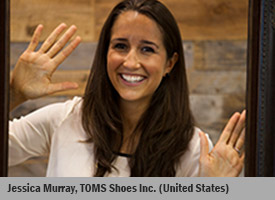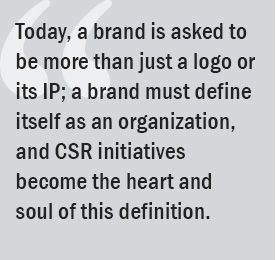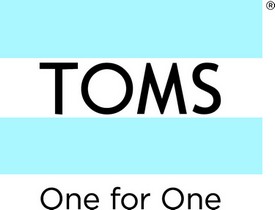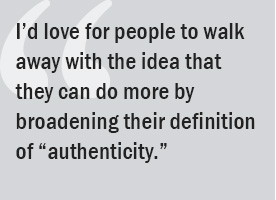Interviews
Jessica Murray, TOMS Shoes, Inc.: Changing the Game by Changing Lives
Published: October 15, 2017
 Jessica Murray (TOMS Shoes, Inc., USA) has spent her career protecting brands across sectors like luxury goods, hospitality, and apparel. Over the years, Ms. Murray has become keenly aware that brand enforcement depends in large part on reinforcing the unique aspects of a brand that ensure customer loyalty. When she joined TOMS Shoes in 2013, that connection became even clearer.
Jessica Murray (TOMS Shoes, Inc., USA) has spent her career protecting brands across sectors like luxury goods, hospitality, and apparel. Over the years, Ms. Murray has become keenly aware that brand enforcement depends in large part on reinforcing the unique aspects of a brand that ensure customer loyalty. When she joined TOMS Shoes in 2013, that connection became even clearer.
As Director of Intellectual Property and Corporate Social Responsibility (CSR) at TOMS, Ms. Murray has a unique perspective on brand protection that she will share with registrants of INTA’s Brand Authenticity conference, which will be held November 30‒December 1 in Berlin, Germany. As conference co-chair, Ms. Murray has played an integral role in shaping the discussion that will take place, which she hopes will result in a more “holistic” approach to companies’ brand protection strategies. Below, she shares more with the INTA Bulletin about TOMS’ unique approach to this topic and her goals for the conference.
What does your role with TOMS Shoes entail?
I was hired four and a half years ago by TOMS to build their brand protection and IP portfolio. The position was new for the company and allowed for a far broader scope of work, deep diving into the essence of protecting what is uniquely TOMS. I was brought in strictly for brand protection, but as I looked into what made the brand authentic, I realized it was inextricably linked to its CSR program; so my title evolved into Director of IP and CSR.
What is TOMS’ CSR program? Most people know that TOMS provides shoes to those in need, but you also do a lot more—what else does the program involve?
TOMS started 11 years ago with the idea that for every pair of shoes purchased, a pair of shoes would be given to a child in need. That came out of a trip the founder [Blake Mycoskie] took in 2006 to Argentina, where he saw that children who didn’t have shoes couldn’t go to school. That created this growing cycle of poverty—because they couldn’t go to school, they couldn’t get out of poverty, and vice versa. By providing shoes, they were able to go to school, and that spawned our “One for One” mission.
 TOMS is really about improving the lives of others through business. Today, our program is far more than shoe giving: we give water, sight [via prescription glasses or medical treatment], bullying prevention training, and safe birth training in over 70 countries. The program is rooted in this idea that we really need to push ourselves to do more to improve life through business and push others to do the same.
TOMS is really about improving the lives of others through business. Today, our program is far more than shoe giving: we give water, sight [via prescription glasses or medical treatment], bullying prevention training, and safe birth training in over 70 countries. The program is rooted in this idea that we really need to push ourselves to do more to improve life through business and push others to do the same.
How do you decide where and how to help?
We work with “giving partners” around the world. They’re our eyes on the ground and they provide us with insight as to what’s needed where. Shoes sometimes may not be the best “give,” for instance, so we might invest in helping to eradicate diseases in a certain region through a targeted “give.” What started as this very simple idea has now evolved into a much broader view of all the ways we can make an impact.
Do you think that CSR and brand protection should be linked in this way for all companies, or is TOMS a unique case?
Today, a brand is asked to be more than just a logo or its intellectual property; a brand must define itself as an organization and CSR initiatives become the heart and soul of this definition. TOMS’ social impact is part of its mission statement, but most companies today are being asked by consumers to acknowledge their social and environmental impact, putting a lens on the authenticity of the brand.
What lessons do you have for other companies that are just beginning to make this connection, based on your experience at TOMS so far?
TOMS started their business on the founding principle that it would improve lives by doing business. We have learned along the way and adjusted accordingly. Acknowledging shortcomings but remaining steadfast to our resolve is imperative to the success of our program. As demands from both the business and consumers grow, using our brand principles to create short- and long-term initiatives is imperative to our authenticity. Finding the right balance is a struggle for all brands. Also, in order for a CSR program to be successful, executive board sign-off is essential, as this allows a truly authentic program to be weaved into all aspects of a company and pushes employees on a day-to-day basis. For example, in 2013, TOMS committed to producing one third of our Giving Shoes in the regions where we give them. Local production helps to build industry and create jobs and sustainable futures. We could not do this without the full support of the executive team, who made it a priority for the organization.
TOMS Giving Program

More than shoes—TOMS gives directly to communities in need through the following programs:
- Shoes
- Sight—via prescription glasses, sight-saving surgery, and medical treatment
- Improved access to water
- Safe birth training
- Bully prevention training
TOMS also goes beyond the “one-for-one” model by:
- Providing 700+ jobs through its Giving Shoe production in 4 countries
- Funding 20+ startups with a social mission
- Producing 100% sustainably sourced coffee
Why did you agree to co-chair INTA’s Brand Authenticity conference?
I was delighted to hear that there was interest in exploring this crossover into a different area. This concept of brand authenticity seems to be where we’ll hopefully be heading across the board with brands; it’s clearly very important to me, but there’s also such passion with the people who work in this area and I think it’s important to expose them to new groups of people—such as IP lawyers, brand owners, and other professionals—in order to educate one another and foster new discussions internally. We want to reshape the way we look at our brands and CSR programs across the world with this conference.
What approach will the conference take in shaping this discussion?
It’s going to be a unique and exciting program, but we wanted to do it in a way that is understandable to people who aren’t used to these cross-functions. The purpose of the conference is to spark interest and reshape the conversation. We want small firms, brand owners, vendors, and whoever attends to take a more holistic view of authenticity.

We looked for ways to bridge this gap by focusing on familiar topics from a new angle. There will be a discussion on 3D printing, for instance, which is a hot topic in the IP world, but we’ll think about it from the perspective of brand authenticity and sustainability. I will be moderating a session about how brand owners are looking at sustainability and CSR as part of their brand protection programs. We’ll talkabout how CSR and other aspects of brand authenticity can be used to help build integrity in brand protection programs. There will be some interesting discussions about what it means to be “green” with respect to labeling, and how to make that information really integral to your brand and remain true—a topic that in Europe they’ve been really ahead of the curve on. Those are some of the sessions that sparked interest for me. And of course there will also be a lot of policy discussions, which will be really important as part of CSR programs, and we want to help attendees understand them.
Who do you think should attend the conference?
Brand owners, but it’s not just for this group—law firms can bring back education to firms and clients, vendors can understand more about the challenges brand owners face and how to find solutions to them. There are attendees joining us who are experts, even pioneers in this field, while others are just starting to navigate these difficult questions. I see it as an olive branch in an effort to form a larger network to support each other as we push to find answers to these evolving brand authenticity questions.
Have you learned anything from helping to plan the conference?
What I’ve learned is that it’s difficult for us to break some of these rigid IP role-defining barriers, especially on paper. Some people see these as very bucketed topics, and it’s challenging to shift the needle to a more holistic approach. However, it’s very compelling once you can speak to someone about it and explain what it really is. The INTA staff who are involved with the conference have been so great about reaching out to people who might not understand the concept fully at first, and once they speak to her it’s so clear. It’s a challenge to try to change things, but I think INTA is really leading the charge in an exciting way and changing the dynamic of what it is to be in these roles and pushing to conceptualize it. INTA is putting a lens on how we will all function in the future and getting ahead of it. It’s exciting, but comes with its own difficulties at the same time.
What do you hope people take away from the conference?
I’d love for people to walk away with the idea that they can do more by broadening their definition of “authenticity.”
Register now for INTA’s Brand Authenticity conference, taking place in Berlin, Germany, November 30–December 1, 2017.
This conference preceded by a Free Trade Zones Workshop on November 29. INTA has created this series of one-day workshops to provide a forum for brand owners, free trade zone authorities, government officials, and other key stakeholders to share their concerns and best practices and to work together toward solutions to combat the ongoing threat of counterfeiting in free trade zones. Learn more and register here.
Although every effort has been made to verify the accuracy of items in the INTA Bulletin, readers are urged to check independently on matters of specific concern or interest.
© 2017 International Trademark Association